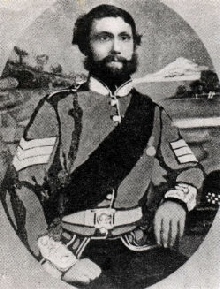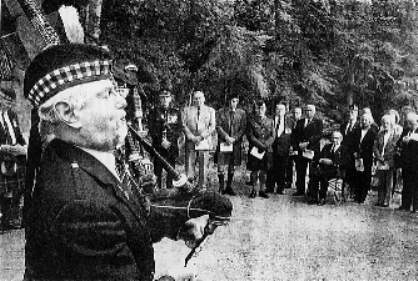Colour Sergeant James Munro VC
Soldiers honour Highland hero
left forgotten in pauper's grave
Article from the Press & Journal
Aberdeen Edition 26/07/02
Copyright Press & Journal
Photographs supplied
by
NORTHPIX, Inverness

A FORGOTTEN Highland war hero is to be honoured 145 years after he won the Victoria Cross for rescuing a wounded officer under fire.
It emerged yesterday that despite receiving this country's highest award for gallantry from Queen Victoria in person, Colour Sergeant James Munro was left a broken man.
Instead of being the toast of the town as so many heroes were in Victorian times, he died a mental and physical wreck alone in a Highland asylum, the victim of the terrible wounds he received when he returned to the fray.
Investigations by the Army has discovered that Col Sgt Munro died in Craig Dunain Hospital, Inverness, which in Victorian times was called the lunatic asylum, and his body was buried in a pauper's graveyard in the grounds.
The tiny walled cemetery closed in 1893, and since then has lain overgrown and forgotten
But now, in honour of Col Sgt Munro, the Army has cleared away the trees and bushes masking the sad little burial place, and soon a plaque marking his last resting place will be erected, possibly along with a storyboard telling of his bravery and the background to the cemetery.
Munro's heroism was displayed on November 6, 1857, when his regiment, the 93d Sutherland Highlanders, was involved in fierce action during the relief of Lucknow, a notable action during the Indian Mutiny.
Munro's VC citation is in the briefest of terms. It states: "Munro, James. For devoted gallantry at Secundra Bagh, in having promptly rushed to the rescue of Captain Walsh of the same corps, when wounded and in danger of his life, whom he carried to a place of safety, to which the sergeant was brought in shortly afterwards badly wounded."
Munro was shot through his loins by two musket balls, which shattered his lower vertebrae, tearing bone away and leaving wounds that never properly healed.
Through amalgamation, Munro's regiment became the famous Argyll and Sutherland Highlanders, and it is soldiers of their regiment's Stirling-based E Company Assault Pioneers that are helping with the clearance work at Craig Dunain Hospital, which recently closed and is lying empty.
Lieutenant Colonel Malcolm McVittie, chairman of the regimental association, which is funding much of the work, said: "Normally we don't spend money on the dead. Our money is mostly spent helping the living.
"But having discovered this information about Col Sgt Munro, we are now trying to put right what was wrong before, in full co-operation with the hospital trust that owns the land.
"It is very sad that a soldier with such a distinguished record should have died and been buried in such circumstances"
Once work is completed the regimental association plans to hold a small ceremony.
Munro is believed to have been born on October 11, 1826, the son of a wright at Easter Rariche, Nigg, Easter Ross, and died in February 5 1871, aged 45, some 13 years after his bravery. He was 20 when he joined up, and by 1854 he was a sergeant serving in the Crimean War.
Eighteen months later, the regiment went to India and in 1857 Munro was promoted to colour sergeant. On his return to Britain he was declared unfit for further duty and left the Army after more than 12 years.
Lt Col McVittie's research revealed he had a good-conduct medal and was receiving good-conduct pay from 1851.
Munro received his medal from Queen Victoria at Windsor Castle in 1860, two years after he was discharged.
The next that is documented about Munro is when he came to the attention of Edinburgh police while working as a ranger in the Queen's Park, now Holyrood Park.
He had become demented and a kleptomaniac, most likely through a combination of his terrible wounds and the alcohol he consumed to help him get through life.
He was also becoming paralysed as a result of his injuries and was said to have been demented in appearance.
Munro was 44 when admitted to hospital in Inverness, and died the next year. Records show he may have been married to a Jessie Ross from Tain.
The Inverness graveyard where James Munro was laid to rest
Forgotten VC hero honoured at last
Article from the Press & Journal by Andrew Black
Highland Edition 16/09/02
Copyright Press & Journal
 A FORGOTTEN Highland war hero who was awarded the Victoria Cross for rescuing a wounded officer under fire - but who later died in a lunatic asylum - has been honoured 145 years after receiving his medal.
A FORGOTTEN Highland war hero who was awarded the Victoria Cross for rescuing a wounded officer under fire - but who later died in a lunatic asylum - has been honoured 145 years after receiving his medal.
Despite receiving the country's highest award for gallantry from Queen Victoria, Colour Sergeant James Munro died a mental and physical wreck alone in Craig Dunain Hospital, Inverness, which in Victorian times was called the lunatic asylum.
But he has now been recognised with a memorial stone in the grounds of the former hospital where he was buried.
After he received his medal in 1860, two years after he was discharged, he came to the attention of police in Edinburgh while working as a ranger in the Queen's Park, now Holyrood Park.
He was said to have become a demented kleptomaniac and an alcoholic and was becoming paralysed because of terrible wounds he received in action.
He was admitted to hospital in Inverness when he was 44 and died the following year.
His body was buried in a graveyard in the hospital grounds but after the cemetery closed in 1895, it became overgrown and forgotten.
Munro's heroism was displayed on November 6, 1867, when his regiment, the 93rd Sutherland Highlanders, was involved in fierce action during the relief of Lucknow.
Munro's brief VC citation read: "Munro, James. For devoted gallantry at Secundra Bagh, in having promptly rushed to the rescue of Captain Walsh of the same corps, when wounded and in danger of his life, whom he carried to a place of safety, to which the sergeant was brought in shortly afterwards badly wounded.

Piper Ian Mackenzie plays a lament for
Sergeant James Munro VC.
Picture by Les Parker
